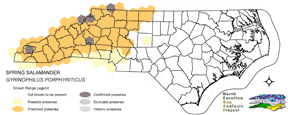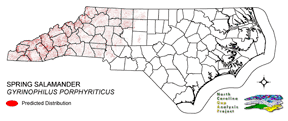
| Taxa: |
| Order: |
| Family: |
| Amphibia |
| Caudata |
| Plethodontidae |
| NatureServe Global Rank: |
| NatureServe State (NC) Rank: |
| G5 |
| S5 |
| Federal Status: |
| NC State Status: |
| --- |
| --- |


| Land Unit |
| US Fish & Wildlife Service |
| US Forest Service |
| US National Park Service |
| US Department of Defense |
| NC State Parks |
| NC University System |
| NC Wildlife Res. Com. |
| NC Forest Service |
| NC Div. of Coastal Mgmt. |
| Local Governments |
| Non-Governmental Org. |
| Other Public Lands |
| Private Lands |
| GAP Status 1-2 |
| All Protected Lands |
| Statewide |
| Hectares |
| 2.52 |
| 88,770.51 |
| 50.22 |
| 30,830.22 |
| 2,133.81 |
| 58.68 |
| 2,598.21 |
| 559.62 |
| 0.00 |
| 1,920.42 |
| 2,054.61 |
| 23.67 |
| 375,995.52 |
| 45,421.20 |
| 128,840.85 |
| 504,998.01 |
| Acres |
| 6.23 |
| 219,356.66 |
| 124.10 |
| 76,183.12 |
| 5,272.76 |
| 145.00 |
| 6,420.32 |
| 1,952.63 |
| 0.00 |
| 4,745.46 |
| 5,077.05 |
| 58.49 |
| 929,104.98 |
| 112,807.98 |
| 318,942.39 |
| 1,248,446.79 |
| % of Dist. on |
| Prot. Lands |
| < 0.1 % |
| 68.9 % |
| < 0.1 % |
| 23.9 % |
| 1.7 % |
| < 0.1 % |
| 2.0 % |
| 0.4 % |
| 0.0 % |
| 1.5 % |
| 1.5 % |
| 0.0 % |
| 0.0 % |
| 35.3 % |
| ----- |
| ----- |
| % of Dist. on |
| All Lands |
| < 0.1 % |
| 17.6 % |
| < 0.1 % |
| 6.1 % |
| 0.4 % |
| < 0.1 % |
| 0.5 % |
| 0.1 % |
| 0.0 % |
| 0.4 % |
| 0.4 % |
| < 0.1 % |
| 74.5 % |
| 9.0 % |
| ----- |
| ----- |
|
This species is found in the mountains and upper piedmont (Martof et al. 1980). The spring salamander inhabits small, cold flowing-water situations (seeps, springs, and streams) with rocky substrates, often in uplands (Wilson 1995). Sometimes this salamander will be found in forested wet areas away from streams. Caves and crevices at the base of damp riparian rockfaces are also used (Martof et al. 1980). NATURE SERVE GLOBAL HABITAT COMMENTS: Small, clear upland streams; clear springs; caves; shaded seepages; occasionally in swamps and lake margins. Sometimes also in forested wet areas away from streams, especially during rainy periods. Often under rocks, logs, leaves, or moss in or near water. Eggs usually are attached to undersides of rocks in running water. |
| Code | Name | Description | NC Natural Heritage Program Equivalent |
| 238 | Piedmont/Mountain Submerged Aquatic Vegetation | Seasonally to permanently flooded areas with aquatic vegetation. Waterlily, pondweed, hydrilla smartweed are a few of the species that can occur. | Piedmont/Mountain Semipermanent Impoundment (in part) |
| 239 | Piedmont/Mountain Emergent Vegetation | Emergent vegetation of all wetland hydrologies. Sites would commonly support species such as tussock sedge, rushs, and cattail alliances. | Rocky Bar and Shore (in part) |
| 230 | Piedmont Mesic Forest | American Beech - Red Oak - White Oak Forests. | Mesic Mixed Hardwood |
| 383 | Piedmont Mixed Successional Forest | Generally loblolly mixed with successional hardwoods. Sweetgum, tulip poplar and red maple are common co-dominants in these successional forests. | No equivalent |
| 214 | Barren; bare rock and sand | Areas of bare rock, sand or clay. | No equivalent |
| 202 | Residential Urban | Includes vegetation interspersed in residential areas. Includes lawns, mixed species woodlots, and horticultural shrubs. Vegetation accounts for between 20 - 70% of the cover. | No equivalent |
| 8 | Open water | Open water without aquatic vegetation. | No equivalent |
| 517 | Hemlock Floodplain Forest | Alluvial forest with hemlock and/or white pine in mountains and western piedmont. Hydrology is generally temporarily to seasonally flooded. | Canada Hemlock Forest |
| 525 | Appalachian Oak Forest | A variety of oak forest types including Black, White, Scarlet Oaks in dry to mesic situations. Includes forests historically co-dominated by American Chestnut. | High Elevation Red Oak Forest, Montane White Oak Forest |
| 526 | Appalachian Cove Forest | Mixed Mesophytic forests of the mountains. Includes tuliptree, basswood, yellow buckeye and surgar maple. This class is mapped to include cove forests dominated or co-dominated by hemlock. | Rich Cove Forest, Acidic Cove Forest |
| 527 | Appalachian Hemlock | Upland hemlock forests of the moutains region. Vary from side slopes to steep slope positions. | Canada Hemlock Forest |
| 533 | Appalachian Swamp Forest | Evergreen and deciduous forests with saturated hydrologies. This class may contain a variety of trees species, including hemlock - red maple, pitch pine, and white pine forests. | Swamp Forest-Bog Complex, Southern Appalachian Bog, Southern Appalachian Fen |
| 534 | Appalachian Wet Shrubland/ Herbaceous | Saturated shrubs and herbaceous vegetation. Often mapped as an inclusion in Appalachian Swamp Forest. | Southern Appalachian Bog, Southern Appalachian Fen |
|
Brandon, R. A. 1967. GYRINOPHILUS PORPHYRITICUS. Cat. Am.Amph. Rep. 33.1-33.3.
Blaney, R. M., and P. K. Blaney. 1978. Significance of extreme variation in a cave population of the salamander GYRINOPHILUS PORPHYRITICUS. Proceedings West Virginia Academy Science 50:23. Wilson, L. A. 1995. The Land Manager's Guide to the amphibians and reptiles of the South. Chapel Hill, NC: The Nature Conservancy. Barbour, R. W. 1971. Amphibians and reptiles of Kentucky. Univ. Press of Kentucky, Lexington. x + 334 pp. Mount, R. H. 1975. The Reptiles and Amphibians of Alabama. Auburn University Agricultural Experiment Station, Auburn, Alabama. vii + 347 pp. Behler, J. L., and F. W. King. 1979. The Audubon Society field guide to North American reptiles and amphibians. Alfred A. Knopf, New York. 719 pp. Martof, B. S., W. M. Palmer, J. R. Bailey, and J. R. Harrison, III. 1980. Amphibians and reptiles of the Carolinas and Virginia. University of North Carolina Press, Chapel Hill, North Carolina. 264 pp. DeGraaf, R. M., and D. D. Rudis. 1983. Amphibians and reptiles of New England. Habitats and natural history. Univ. Massachusetts Press. vii + 83 pp. Green, N. B., and T. K. Pauley. 1987. Amphibians and reptiles in West Virginia. University of Pittsburg Press, Pittsburg, Pennsylvania. xi + 241 pp. Resetarits, W. J., Jr. 1991. Ecological interactions among predators in experimental stream communities. Ecology 72:1782-1793. |
For more information please contact them at:
NC-GAP Analysis Project
Dept. of Zoology, NCSU
Campus Box 7617
Raleigh, NC 27695-7617
(919) 513-2853
www.basic.ncsu.edu/ncgap